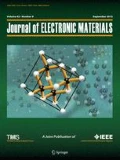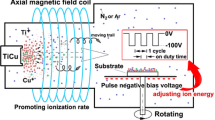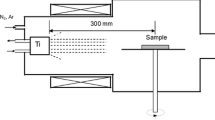Abstract
Dry etching of multilayer magnetic thin film materials is necessary for the development of sensitive magnetic field sensors and memory devices. The use of high ion density electron cyclotron resonance (ECR) plasma etching for NiFe, NiFeCo, TaN, and CrSi in SF6/Ar, CH4/H2/Ar, and Cl2/Ar plasmas was investigated as a function of microwave source power, rf chuck power, and process pressure. All of the plasma chemistries are found to provide some enhancement in etch rates relative to pure Ar ion milling, while Cl2/Ar provided the fastest etch rate for all four materials. Typical etch rates of 3000Å/min were found at high microwave source power. Etch rates of these metals were found to increase with rf chuck power and microwave source power, but to decrease with increasing pressure in SF6/Ar, CH4/H2/Ar, and Cl2/Ar. A significant issue with Cl2/Ar is that it produces significant metal-chlorine surface residues that lead to post-etch corrosion problems in NiFe and NiFeCo. However, the concentration of these residues may be significantly reduced by in-situ H2 or O2 plasma cleaning prior to removal of the samples from the etch reactor.
Similar content being viewed by others
References
C. Tsang, M. Chen, T. Yogi and K. Ju, IEEE Trans. Magn. 30, 281 (1994).
S. Wang, F. Liu, K.D. Maranowski and M.H. Kryder, IEEE Trans. Magn. 26, 1689 (1989).
See for example G.A. Prinz, Ultra-Thin Magnetic Structures II, ed. B. Heinrich and J.A.C. Bland (Berlin: Springer-Verlag, 1994).
M.J. Vasile and C.J. Mogab, J. Vac. Sci. Technol. A 4, 1841 (1986).
F.C.M.J. van Delft, J. Magn. Mag. Mater. 140, 2203 (1995).
B. Gorowitz, R.J. Saia and E.W. Balch, VLSI Electronics Microstructural Science, ed. N.G. Einspruch, S.S. Cohen and G. Gildenblat, Vol. 15 (Orlando, FL: Academic Press, 1987), Chap. 4.
A.K. Sinha, H.S. Lindenburger, D.B. Fraser, S.P. Murarka and E.N. Fuls, IEEE Trans. Electron Dev. ED-27, 1425 (1980).
D.W. Hess, Plasma Chem. Plasma Proc. 2, 141 (1982).
T.M. Mayer, J.M.E. Harper and J.J. Cuomo, J. Vac. Sci. Technol. A 3, 1779 (1985).
J.M.E. Harper, Plasma Etching-An Introduction, ed. D.M. Manos and D.L. Flamm (San Diego, CA: Academic Press, 1989), Chap. 6.
K. Kinoshita, IEEE Trans. Magn. 27, 4888 (1991).
J.W. Lee, S.J. Pearton, C J. Santana, J.R. Mileham, E.S. Lambers, C.R. Abernathy, F. Ren and W.S. Hobson, J. Electrochem. Soc. 143, 1093 (1996).
CRC Handbook of Chemistry and Physics, 72nd Ed. (Boca Raton, FL: CRC Press, 1989).
M.A. Liebermann and A.J. Lichtenburg, Principles of Plasma Discharges and Materials Processing (New York: John Wiley and Sons, 1994).
Author information
Authors and Affiliations
Rights and permissions
About this article
Cite this article
Jung, K.B., Lee, J.W., Park, Y.D. et al. Electron cyclotron resonance plasma etching of materials for magneto-resistive random access memory applications. J. Electron. Mater. 26, 1310–1313 (1997). https://doi.org/10.1007/s11664-997-0076-x
Received:
Accepted:
Issue Date:
DOI: https://doi.org/10.1007/s11664-997-0076-x




